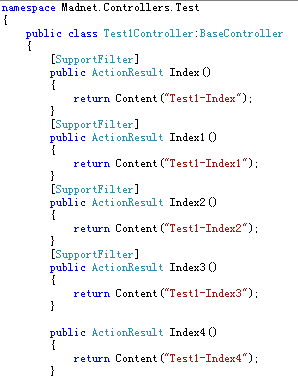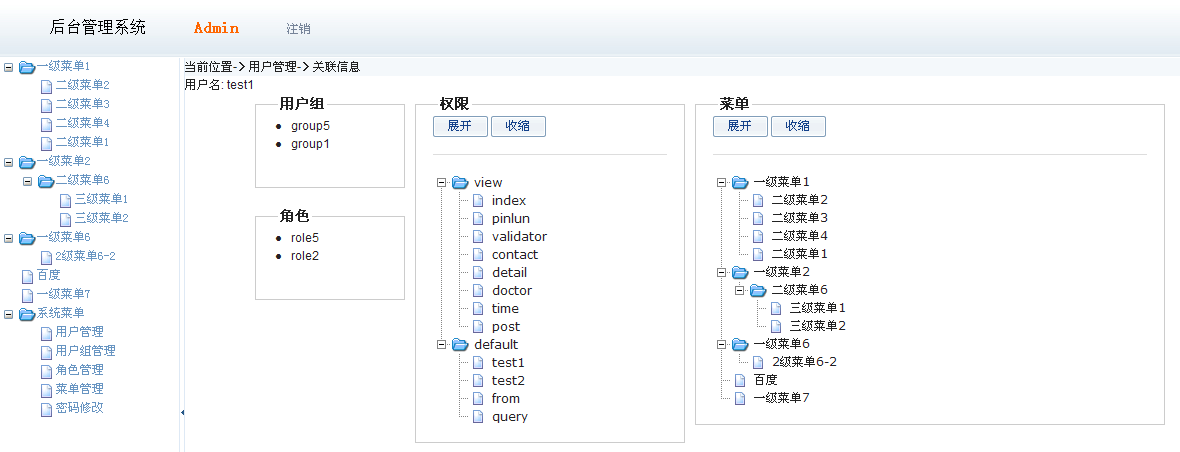一个基于Asp.Net MVC的权限方案
作者:
最近这段时间博客园有几位同学在探讨通用的权限方案,偶闲来无事,也来凑凑热闹,下面简单说一下我的简单解决方案,基于AOP的。由于使用了Asp.Net MVC 开发,可能需要先对MVC有些了解,思路都是差不多的。
1.数据结构

Mad_Popedom为权限表,Control记录控制器名,Action记录动作名。
Mad_Role为角色表。
using System.Collections.Generic;
using System.Web.Mvc;
using Madnet.Model.MadAdmin;
using Madnet.BLL.MadAdmin;
namespace Madnet.Controllers.MadAdmin
{
public class SupportFilterAttribute : ActionFilterAttribute
{
private bool _IsLogin = true;
/// <summary>
/// 是否需要登录
/// </summary>
public bool IsLogin
{
set
{
_IsLogin = value;
}
get
{
if (System.Configuration.ConfigurationManager.AppSettings["IsLogin"] != null)
{
bool.TryParse(System.Configuration.ConfigurationManager.AppSettings["IsLogin"].ToString(), out _IsLogin);
}
return _IsLogin;
}
}
public override void OnActionExecuting(ActionExecutingContext filterContext)
{
string controllerName = (string)filterContext.RouteData.Values["controller"];
string actionName = (string)filterContext.RouteData.Values["action"];
if (IsLogin && filterContext.HttpContext.Session["Login_User"] == null)
{
filterContext.HttpContext.Response.Redirect(new UrlHelper(filterContext.RequestContext).Action("Login", "Default"));
filterContext.Result = new EmptyResult();
}
else if (IsLogin && filterContext.HttpContext.Session["Login_User"] != null)
{
Mad_User user = filterContext.HttpContext.Session["Login_User"] as Mad_User;
if (!user.is_super)
{
if (!GetPopedom(user).Exists(p => p.Controller_Name == controllerName.ToLower() && p.Action_Name == actionName.ToLower()))
{
filterContext.HttpContext.Response.Write("没有权限");
filterContext.Result = new EmptyResult();
}
}
}
}
/// <summary>
/// 获取当前用户所有有权限执行的动作
/// </summary>
/// <returns></returns>
public List<Atmodel> GetPopedom(Mad_User user)
{
List<Atmodel> ats = new List<Atmodel>();
List<Mad_Popedom> pops = Mad_PopedomBLL.GetPopedombyUser(user.user_id);
foreach (Mad_Popedom pop in pops)
{
ats.Add(new AtModel() { Controller_Name = pop.Control, Action_Name = pop.Action });
}
return ats;
}
}
}

Mad_Popedom为权限表,Control记录控制器名,Action记录动作名。
Mad_Role为角色表。
2.权限控制的实现
此处使用比较简单AOP方式,用MVC的Filter实现,代码如下
复制代码 代码如下:
using System.Collections.Generic;
using System.Web.Mvc;
using Madnet.Model.MadAdmin;
using Madnet.BLL.MadAdmin;
namespace Madnet.Controllers.MadAdmin
{
public class SupportFilterAttribute : ActionFilterAttribute
{
private bool _IsLogin = true;
/// <summary>
/// 是否需要登录
/// </summary>
public bool IsLogin
{
set
{
_IsLogin = value;
}
get
{
if (System.Configuration.ConfigurationManager.AppSettings["IsLogin"] != null)
{
bool.TryParse(System.Configuration.ConfigurationManager.AppSettings["IsLogin"].ToString(), out _IsLogin);
}
return _IsLogin;
}
}
public override void OnActionExecuting(ActionExecutingContext filterContext)
{
string controllerName = (string)filterContext.RouteData.Values["controller"];
string actionName = (string)filterContext.RouteData.Values["action"];
if (IsLogin && filterContext.HttpContext.Session["Login_User"] == null)
{
filterContext.HttpContext.Response.Redirect(new UrlHelper(filterContext.RequestContext).Action("Login", "Default"));
filterContext.Result = new EmptyResult();
}
else if (IsLogin && filterContext.HttpContext.Session["Login_User"] != null)
{
Mad_User user = filterContext.HttpContext.Session["Login_User"] as Mad_User;
if (!user.is_super)
{
if (!GetPopedom(user).Exists(p => p.Controller_Name == controllerName.ToLower() && p.Action_Name == actionName.ToLower()))
{
filterContext.HttpContext.Response.Write("没有权限");
filterContext.Result = new EmptyResult();
}
}
}
}
/// <summary>
/// 获取当前用户所有有权限执行的动作
/// </summary>
/// <returns></returns>
public List<Atmodel> GetPopedom(Mad_User user)
{
List<Atmodel> ats = new List<Atmodel>();
List<Mad_Popedom> pops = Mad_PopedomBLL.GetPopedombyUser(user.user_id);
foreach (Mad_Popedom pop in pops)
{
ats.Add(new AtModel() { Controller_Name = pop.Control, Action_Name = pop.Action });
}
return ats;
}
}
}
解释一下,上面的代码就是在执行前,先获取登录用户可以运行的Controller-Action,然后和当前需要执行的Controller-Action比较,如存在,即通过,否则为没有权限执行。
3.为动作添加权限
为简单起见,对于Controller层我是独立出来一个类库的,好处是等会为角色添加权限的时候我们不需要手动输入,只要反射dll就可以了。
如图所示,凡需要权限控制的函数,只需要添加[SupportFilter]特性就可以了,当然这种方式只能控制到Action级。
4.为角色额添加权限
这个比较简单,只需要把角色和权限关联起来就可以了,这里我是用反射Controller层dll实现。
Web.config
Global.asax.cs
Madnet.Controllers.Test即为Controller层的dll
Test为Controller名,index为Action名,选择role2可以访问的Action,提交到数据库即可。此图表示role2拥有Test1Controller的访问权限,但是没有Test2Controller,Test3Controller的访问权限。
5.结束
上面4步即已完成基本的权限控制。可以在此基础上加上用户组,用户,菜单等管理,可实现”用户-角色-权限”的自由组合,一个简单的通用后台大概就是这样了。
您可能感兴趣的文章:
- asp.net membership 密码重设
- asp.net 权限管理分析
- asp.net Forms身份验证和基于角色的权限访问
- 实例说明asp.net中的简单角色权限控制
- asp.net 基于forms验证的目录角色权限的实现
- 获取创建Membership的数据库创建脚本
- asp.net+sqlserver实现的简单高效的权限设计示例
- asp.net BasePage类+Session通用用户登录权限控制
- Asp.net Mvc 身份验证、异常处理、权限验证(拦截器)实现代码
- ASP.NET MVC 中实现基于角色的权限控制的处理方法
- ASP.NET通用权限验证的实现代码思路
- 初识 ASP.NET Membership 用户管理
